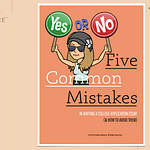Christine: Let’s look at high school counselors who are serving almost 400 or 500 students to one counselor.
Tom: Right. And they’re not the college counselors from my day. These are school counselors who are doing a lot of other things too. They don’t have the opportunity to do the one-on-one on a regular basis. Unfortunately, they’re doing it in what I describe as the oil-and-vinegar process — and that is, the oil rises to the top. So those are the individuals counselors are going to work with. Those are the individuals who have squeaky parents who are calling us. Those are the individuals who have some financial breath.
So, to some degree, why not leave them alone? Why not leave the top third of the class alone? Because they're going to survive on their own. Put all of your attention on the bottom third of the class to see what you can do for them, because those individuals, number one, as we’ve talked before and I preach a lot about, they shouldn’t become the part of the 20 percent population that are emotionally sent to college or emotionally go to college because everybody else is doing it and leave after their first year. They should be the ones who might need an idea of doing a gap year or going to work or going to community college.
Christine: Let’s remind people what that 23 percent is. What’s the 23 percent?
[According to the most recent data from the National Student Clearinghouse Research Center, around 23.5 percent of college students who started as freshmen in 2024 did not return for their sophomore year, as the “persistence rate” (meaning the percentage returning to any college) is presently at 76.5 percent.]
The 20 percent are, and that’s on the low end, that’s the average number of students who go to college and leave after their first year. And they leave because of academic readiness and the inability to pay the bill. And they also leave because they are in the wrong social and personal environment for them.
Maybe at a [highly selective] US News and Reports school, it’s 5 percent. But another school that is on the cusp, financially, I mean, their number could be 60 percent. I mean, you know, or it could be 38 percent of students are leaving after the first year.
So there are problems with that because that school is probably not going to be able to recoup. I mean, think about it. If your favorite grocery store or your favorite barber or favorite hair salon loses 20 percent of their population of paying customers after the first year, and they don’t have the ability or they’re not programmed to go after and replace that 20 percent in year two, three and four, that’s money lost.
So how is that organization going to stay in business? That’s the thing.
Christine: Well, that's one side of it. But the second side of it is how much money did that student pay for one year of school, and they're never going to get the return on that investment, because you only get your return on that investment if you graduate.
Tom: Yes. But let’s break it down. All right. You go, and you realize you shouldn’t have been there. You leave. Hopefully you haven’t invested out of your own pocket or through extensive borrowing.
So you go, you experience it, you decide it’s not the place for you, and you use that empowerment to get yourself on the right path. So that’s okay. That’s okay.
But if you come home, like I think the average student does, and you’re demoralized, you’re emotionally troubled, you’re in debt, you’re in difference with your parents (who probably changed your bedroom around and don’t want you potentially there for another nine months! Okay, that’s maybe not fair to say, but.)
There are a lot of invisible issues that are affecting that individual student. And to get going again, they’re going to miss a full year because chances are the summer is going to be filled with grief and misery, and they’re not going to be in the loop to get into the next September class as a transfer student or as a restart student.
Hopefully, they’ll go to community college, and they’ll get their legs, and then they’ll be off and ride. So, the risk and reward is very, very troubling.
Yeah. So, they didn’t get this, and you can take that conversation further. How many students graduate in four years? How many students don't graduate at all?
They stick it out for three or four years, and they don't graduate at all. There’s a number for that. How many students graduate in six years? And that's the number that when most people look at a college website or media information, they’re quoting graduation rates based on six years, not four years.
That’s a huge problem. And if we can, help that, then that’s going to stem the tide of 20 percent of the population coming out of the city or town.
Post-Vietnam, when everybody was coming back that survived the war, the emphasis was, “Go to college, get an education, better yourself, better the world, better the U.S.” Well, that was fine until it got so competitive and so expensive.
Christine: It got so expensive.
Tom: Matt, my youngest, used to say, I'm going to a college like I saw when we visited with Devlin. They had six cereal dispensers in every dining hall. Well, if you have those kinds of expectations from your customers, then you've got to get a contract with someone to put six cereal dispensers in every dining hall. And if you’ve got seven dining halls, times six, times the people that are going to fill it, times the cereal, I mean, let's be honest, college is a huge business.
I’m talking to an admissions person the other day and (wink wink) if we lose 20 students, we might lose one of our contracts with one of our providers, and that 20 percent, that loss of that contract, is financial revenue that’s coming into our institution through revenue sharing. So we have to show that that we have that population so we can keep that contract alive. You run the gamut on those types of things.
Christine: Look, maybe we’re just at the breaking point, and it’s time for this adjustment to happen. I think if anything, hopefully, it will bring down the price of college. It’s going to force all these things that you and I have been talking about for a long time. Colleges will specialize. They’re going to get a little bit more efficient at what they’re offering students. There’s going to be pain from a lot of different areas in this adjustment.
Tom: Yeah, I don't have an answer for that one.
Christine: I don’t know if we can get from where we are now to where we should or need to be without going through that painful adjustment.
Tom: Well, the only way the painful adjustment is going to occur is that the consumer is going to have to lead the charge. Those that are working within the colleges and universities have too much vested interest to keep the doors open.
Unless they go to their investors or their bankers.
And they turn them away because they can no longer carry the debt of the current campus infrastructure versus adding to it. That’s a tell. That’s a reason to see a school potentially start making changes and they're already doing that we’ve talked about it they’re changing and they’re reducing academic programs. So that affects headcounts, if any program that that’s under-subscribed by, at a point that probably 2 percent or less is going to get examined. So does that get compressed into another program? Does that affect the faculty? Yes. Does that affect the student looking at that school as a viable candidate?
Yes. Is that wrong? Is that bad? No, because we can’t be everything for everybody. We’re not a grocery store. Right. And even grocery stores have different levels of shelving where products are placed.
Okay. So, okay, let’s agree we can’t be everything to everybody anymore. If we’re going to specialize, let’s do it really well. Let’s take on the maximum number of students as we can. Let’s support those programs with smart kids and mediocre or average kids. Let’s be fair to everybody. Or let’s have, you know, one head campus with a massive student service department that funnels four or five other like sister campuses. You can do that when you look at some of the cities and towns or some of the geographic locations of states where there are, five schools within a 30-mile radius of each other.
How can I stay open? Let’s bring them together. One campus specializes in health services. Another one specializes in business. And so on and so forth. You have a central hub of people who are serving that consumers would take that. That's how the health care industry is, you have a central financial department somewhere in the state and the hospital has ERs and emergency care and branch operations.
So why can’t that work in higher ed? It needs someone to think about it. It needs someone to promote it and endorse it. And I think that the current — I’m painting a big paintbrush against the wall — the current people who run the schools, they look inward. How can we stay open?
So it’s happening in some cases the state of Maine has a community college system, Connecticut has a community college system, and Vermont, they’ve started co-mingling some of the operations.
Yes, it affects the head counts. But I think that that's one potential solution. And the other is from a consumer standpoint. You can't be applying to a school that's getting 100,000+ applications for 2,300 seats. You’ve got a better chance with the lottery
Christine: And/or why are you applying to a school if you don't really know what you want to study?
Tom: I mean, I think it’s great for students to take a gap year as long as they have a plan. We’ve talked about that before. Two years ago, I had an opportunity to work with students in that type of situation. I’m talking to one of them tomorrow to catch up to see how he is doing now since he’s made the transition from being split-headed in the fact that he was going to go or not go to I’m not going. Now, what are you doing? And how are you? So I’m looking forward to have that conversation. I'll bring that knowledge back to our next meeting.
Christine: Yeah, I'm excited to hear that.
Tom: Okay. But if we’re not going to go, that’s fine.
Christine: But just floating around and not doing anything isn’t really going to help that student either.
Tom: You can’t be a wanderer, and you can’t use the military as an opportunity. At least in my opinion, having a son who went into the military after college, once you put your feet on those, those, he was a Marine, so you put them on the yellow footprints, you’re there.
Now, of course, you can leave if you say you have a mental issue, and you’re going to kill yourself, they let you out. That’s not a good path for a student who isn’t prepared. That’s just as bad as someone going to college when they’re not academically ready.
Don’t go into the service if you’re not emotionally or physically prepared, or mentally ready.












